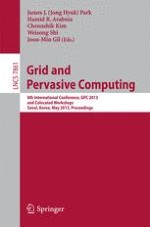This book constitutes the refereed proceedings of the 8th International Conference on Grid and Pervasive Computing, GPC 2013, held in Seoul, Korea, in May 2013 and the following colocated workshops: International Workshop on Ubiquitous and Multimedia Application Systems, UMAS 2013; International Workshop DATICS-GPC 2013: Design, Analysis and Tools for Integrated Circuits and Systems; and International Workshop on Future Science Technologies and Applications, FSTA 2013. The 111 revised papers were carefully reviewed and selected from numerous submissions. They have been organized in the following topical sections: cloud, cluster and grid; middleware resource management; mobile peer-to-peer and pervasive computing; multi-core and high-performance computing; parallel and distributed systems; security and privacy; ubiquitous communications, sensor networking, and RFID; ubiquitous and multimedia application systems; design, analysis and tools for integrated circuits and systems; future science technologies and applications; and green and human information technology.
